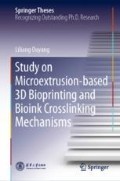Abstract
Chapters 4–6 introduce three bioprinting works using bioinks with different crosslinking mechanisms, mainly from the angles of structural printability and cell viability post-printing. This chapter will present further biological characterization and application based on the specific techniques studied before. Specifically, the printed construct using supramolecular bioinks in Chap. 4 exhibits excellent structure fidelity and mechanical properties and allows for cell adhesion, all of which indicate a promising tissue engineering scaffold. The work in Chap. 5 leads to a perfect balance between structural printability and cell viability by using the easy-accessed and biocompatible bioink, gelatin–alginate hybrid formulation. This technique will be used to further investigate the signal pathway activation and embryonic stem cells’ behavior in 3D-bioprinted constructs. The technology developed in Chap. 6 highlights the use of non-viscous bioinks and flexibility in formulation types and building block complexity. Given this, this work will be used to explore the effects of different ink types and other materials cues on cell behavior, such as morphology.
Access this chapter
Tax calculation will be finalised at checkout
Purchases are for personal use only
References
Ouyang L, Yao R, Chen X, Na J, Sun W (2015) 3D printing of HEK 293FT cell-laden hydrogel into macroporous constructs with high cell viability and normal biological functions. Biofabrication 7(1):015010
Ouyang L, Yao R, Mao S, Chen X, Na J, Sun W (2015) Three-dimensional bioprinting of embryonic stem cells directs high-throughput and highly uniform embryoid body formation. Biofabrication 7(4):044101
Ouyang L, Highley CB, Sun W, Burdick JA (2017) A generalizable strategy for the 3D bioprinting of hydrogels from nonviscous photo-crosslinkable inks. Adv Mater 29(8)
Park J, Cho CH, Parashurama N, Li Y, Berthiaume F, Toner M, Tilles AW, Yarmush ML (2007) Microfabrication-based modulation of embryonic stem cell differentiation. Lab Chip 7(8):1018–1028
Messana JM, Hwang NS, Coburn J, Elisseeff JH, Zhang Z (2008) Size of the embryoid body influences chondrogenesis of mouse embryonic stem cells. J Tissue Eng Regen Med 2(8):499–506
Hwang YS, Chung BG, Ortmann D, Hattori N, Moeller HC, Khademhosseini A (2009) Microwell-mediated control of embryoid body size regulates embryonic stem cell fate via differential expression of WNT5a and WNT11. Proc Natl Acad Sci U S A 106(40):16978–16983
Itskovitz-Eldor J, Schuldiner M, Karsenti D, Eden A, Yanuka O, Amit M, Soreq H, Benvenisty N (2000) Differentiation of human embryonic stem cells into embryoid bodies comprising the three embryonic germ layers. Mol Med 6(2):88–95
Ohnuki Y, Kurosawa H (2013) Effects of hanging drop culture conditions on embryoid body formation and neuronal cell differentiation using mouse embyonic stem cells: optimization of culture conditions for the formation of well-controlled embryoid bodies. J Biosci Bioeng 115(5):571–574
Weeks CA, Newman K, Turner PA, Rodysill B, Hickey RD, Nyberg SL, Janorkar AV (2013) Suspension culture of hepatocyte-derived reporter cells in presence of albumin to form stable three-dimensional spheroids. Biotechnol Bioeng 110(9):2548–2555
Liu HY, Korc M, Lin CC (2018) Biomimetic and enzyme-responsive dynamic hydrogels for studying cell-matrix interactions in pancreatic ductal adenocarcinoma. Biomaterials 160:24–36
Dorsey SM, McGarvey JR, Wang H, Nikou A, Arama L, Koomalsingh KJ, Kondo N, Gorman JH 3rd, Pilla JJ, Gorman RC, Wenk JF, Burdick JA (2015) MRI evaluation of injectable hyaluronic acid-based hydrogel therapy to limit ventricular remodeling after myocardial infarction. Biomaterials 69:65–75
Stowers RS, Allen SC, Suggs LJ (2015) Dynamic phototuning of 3D hydrogel stiffness. Proc Natl Acad Sci U S A 112(7):1953–1958
Khetan S, Guvendiren M, Legant WR, Cohen DM, Chen CS, Burdick JA (2013) Degradation-mediated cellular traction directs stem cell fate in covalently crosslinked three-dimensional hydrogels. Nat Mater 12(5):458–465
Author information
Authors and Affiliations
Corresponding author
Rights and permissions
Copyright information
© 2019 Tsinghua University Press, Beijing and Springer Nature Singapore Pte Ltd.
About this chapter
Cite this chapter
Ouyang, L. (2019). Biological Characterization and Applications. In: Study on Microextrusion-based 3D Bioprinting and Bioink Crosslinking Mechanisms. Springer Theses. Springer, Singapore. https://doi.org/10.1007/978-981-13-9455-3_7
Download citation
DOI: https://doi.org/10.1007/978-981-13-9455-3_7
Published:
Publisher Name: Springer, Singapore
Print ISBN: 978-981-13-9454-6
Online ISBN: 978-981-13-9455-3
eBook Packages: Chemistry and Materials ScienceChemistry and Material Science (R0)

